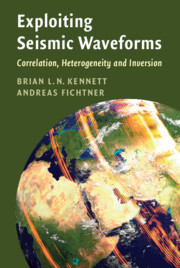Book contents
- Frontmatter
- Dedication
- Contents
- Preface
- 1 Introduction
- Part I Building the Seismic Wavefield
- Part II Correlation Wavefields
- Part III Interaction of Seismic Waves with Heterogeneity
- Part IV Inversion for Earth Structure
- 14 Inference for Structure
- 15 Gradient Methods for Nonlinear Inversion
- 16 Adjoint Methods and Sensitivity Analysis
- 17 Waveform Inversion of Event Data
- 18 Waveform Inversion of Correlation Data
- 19 New Directions
- Appendix Table of Notation
- Bibliography
- Index
18 - Waveform Inversion of Correlation Data
from Part IV - Inversion for Earth Structure
Published online by Cambridge University Press: 16 November 2020
- Frontmatter
- Dedication
- Contents
- Preface
- 1 Introduction
- Part I Building the Seismic Wavefield
- Part II Correlation Wavefields
- Part III Interaction of Seismic Waves with Heterogeneity
- Part IV Inversion for Earth Structure
- 14 Inference for Structure
- 15 Gradient Methods for Nonlinear Inversion
- 16 Adjoint Methods and Sensitivity Analysis
- 17 Waveform Inversion of Event Data
- 18 Waveform Inversion of Correlation Data
- 19 New Directions
- Appendix Table of Notation
- Bibliography
- Index
Summary
The results of cross-correlation of seismic records depend on both the distribution of seismic sources and the structure in the vicinity of the path between the stations being correlated. The differences between the segments of the correlograms corresponding to opposite senses of propagation between the stations provide information on source excitation, while the properties of the dominant arrivals are mainly sensitive to structure.These properties can be exploited in inversion of the correlation wavefield, to extract both noise sources and Earth structure.
- Type
- Chapter
- Information
- Exploiting Seismic WaveformsCorrelation, Heterogeneity and Inversion, pp. 413 - 427Publisher: Cambridge University PressPrint publication year: 2020

